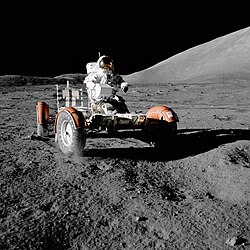Apollo 17

Apollo 17 var den ellevte bemandede mission i Apollo-programmet og den sjette – og sidste – månelanding. For første gang var der en videnskabsmand med, geologen Harrison Schmitt.
Højdepunkter

Det var den første og eneste natlige affyring af Saturn V-raketten — efter sigende kunne man fra kontrolcenteret i Houston se udstødningsflammen fra raketten med det blotte øje, når den kort efter starten fra John F. Kennedy Space Center i Florida kom op over den østlige horisont set fra Houston.
Landingsområdet var geologisk set meget varieret, og med en uddannet geolog på måneoverfladen var der mulighed for at indsamle mange forskellige prøver. Et af de spændende øjeblikke indtraf på den anden månevandring, hvor man stødte på orange månegrus. På Jorden fremkommer den orange farve sædvanligvis fra rust og er dermed et tegn på vand. Det viste sig dog, at den orange farve i månegruset skyldtes små farvede, vulkanske glasperler.
På den første køretur tabte Gene Cernan en hammer ned på den ene skærm på månebilen. Den manglende skærm medførte, at der blev hvirvlet meget månestøv op, men skaden blev udbedret med en "improviseret" skærm lavet af fire plastlaminerede månekort, samlet med klisterbånd.
På vej tilbage mod Jorden gennemførte Ron Evans en rumvandring på 1 time, 5 minutter og 44 sekunder for at hente film ind fra servicemodulet.
Missionen i tal
- Affyring: 7. december 1972 kl.05:33:00 UTC
Kennedy Space Center, LC 39A - Månelanding: 11. december 1972 kl.19:54:57 UTC
20° 11' 26.88" N – 30° 46' 18.05" Ø, Taurus-Littrow - Månevandringer:
- første: 7 timer 11 minutter 53 sekunder
- anden: 7 timer 36 minutter 56 sekunder
- tredje: 7 timer 15 minutter 8 sekunder
- i alt: 22 timer 3 minutter 57 sekunder
- Tid på Månen: 74 timer 59 minutter 40 sekunder
- Indsamlet månemateriale: 110,52 kg
- Landing: 19. december 1972 kl.19:24:59 UTC
17° 53' S – 166° 7' V - Varighed: 301 timer 51 minutter 59 sekunder
- Antal månekredsløb: 75
- Tid i månekredsløb: 147 timer 43 minutter 37,11 sekunder
- Masse: Kommandomodul 30.369 kg; Månelandingsfartøj 16.456 kg
Besætning

- Gene Cernan, chefpilot
- Ron Evans, kommandomodulpilot
- Harrison "Jack" Schmitt, pilot på månelandingsfartøjet
Kommandomodul: America
Månelandingsfartøj: Challenger
Efterskrift
Kommandomodulet er udstillet på NASA's Johnson Space Center, i Houston, Texas. Månelandingsfartøjet styrtede ned på Månen den 15. december 1972 kl.06:50:20.8 UTC på 19,96 N, 30,50 Ø ganske tæt på landingsstedet.

Eksterne henvisninger
 | Wikimedia Commons har medier relateret til: |
- NASA Human Spaceflight Arkiveret 31. oktober 2004 hos Wayback Machine (på engelsk)
- Apollo Lunar Surface Journal Arkiveret 3. august 2004 hos Wayback Machine (på engelsk)
- Encyclopedia Astronautica (på engelsk)
- Kort over landingsområdet Arkiveret 18. november 2004 hos Wayback Machine
| Fulgte efter : Apollo 16 | Apollo-programmet | Fulgt af : Skylab |
|
Medier brugt på denne side
Panorama of the moon taken during mission Apollo 17 (Station 1 East). Composed of 24 images: AS17-134-20408 to AS17-134-20431.
Apollo 17 mission, 12 December 1972.
Astronaut Eugene A. Cernan, commander, makes a short checkout of the Lunar Roving Vehicle (LRV) during the early part of the first Apollo 17 Extravehicular Activity (EVA-1) at the Taurus-Littrow landing site. This view of the "stripped down" LRV is prior to loading up. Equipment later loaded onto the LRV included the ground-controlled television assembly, the lunar communications relay unit, hi-gain antenna, low-gain antenna, aft tool pallet, lunar tools and scientific gear. This photograph was taken by scientist-astronaut Harrison H. Schmitt, lunar module pilot. The mountain in the right background is the east end of South Massif. While astronauts Cernan and Schmitt descended in the Lunar Module (LM) "Challenger" to explore the Moon, astronaut Ronald E. Evans, command module pilot, remained with the Command and Service Modules (CSM) "America" in lunar-orbit.
The prime crew for the Apollo 17 lunar landing mission are: Commander, Eugene A. Cernan (seated), Command Module pilot Ronald E. Evans (standing on right), and Lunar Module pilot, Harrison H. Schmitt. They are photographed with a Lunar Roving Vehicle (LRV) trainer. Cernan and Schmitt will use an LRV during their exploration of the Taurus-Littrow landing site. The Apollo 17 Saturn V Moon rocket is in the background. This picture was taken at Pad A, Launch Complex 39, Kennedy Space Center (KSC), Florida.
This is the official emblem of the Apollo 17 lunar landing mission which was flown by astronauts Eugene A. Cernan, Ronald E. Evans and Harrison H. Schmitt.
- The insignia is dominated by the image of Apollo, the Greek sun god. Suspended in space behind the head of Apollo is an American eagle of contemporary design, the red bars of the eagle's wing represent the bars in the United States flag; the three white stars symbolize the three astronaut crewmen. The background is deep blue space and within it are the moon, the planet Saturn and a spiral galaxy or nebula. The moon is partially overlaid by the eagle's wing suggesting that this is a celestial body that man has visited and in that sense conquered. The thrust of the eagle and the gaze of Apollo to the right and toward Saturn and the galaxy is meant to imply that man's goals in space will someday include the planets and perhaps the stars. The colors of the emblem are red, white and blue, the colors of our flag; with the addition of gold, to symbolize the golden age of space flight that will begin with this Apollo 17 lunar landing. The Apollo image used in this emblem was the famous Apollo of Belvedere sculpture now in the Vatican Gallery in Rome. This emblem was designed by artist Robert T. McCall in collaboration with the astronauts.



